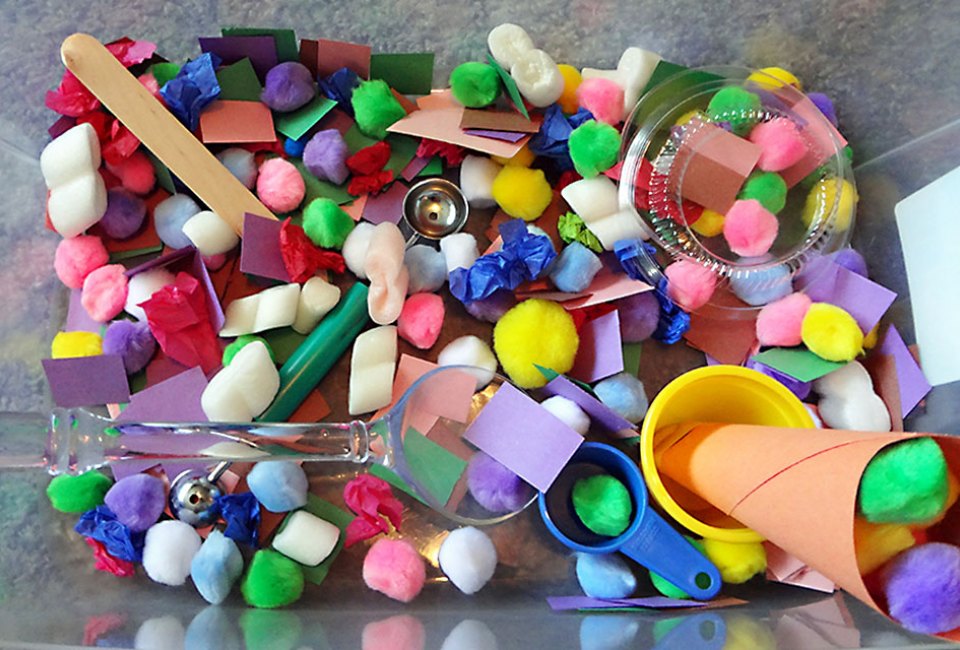native
Toddlers and young children are notorious for getting into everything, especially with their hands. They grab, lunge, and just generally stick their hands into whatever you don't want them to, right? That's one of the reasons I love creating sensory bins for toddlers. It's a nice way to redirect all that crazy toddler energy into something totally fun and (mostly) contained.
Besides, it's a great way for little kids to learn, by actually touching and experiencing something. I've gathered up 10 sensory bin ideas that parents can easily create at home using basic household items. Some employ water, others use soft things or even items that make a sound. Once you discover which sensory bin most appeals to your kid, you might also just have discovered some new free time and a little independent playtime for your youngster.
For more tips on dealing with sensory issues, see our posts on 99 Sensory Activities for Toddlers, Infants, and Kids of All Ages, DIY Sensory Activities for Babies, and Sensory Savvy Snacks for Kids.
Latest Videos
Connatix video player
Preschools and occupational therapists use sensory bins to create experiences for young children, so they can learn how to talk about the world. They learn what textures and sounds they like or don’t like, how to describe how something feels, smells, looks or sounds, and how to differentiate between soft and hard, small and large, liquid and solid, and even warm or cold. In addition to all of that, sensory bins can be great fun.
Parents can build their own sensory bins at home by finding a large, preferably clear, nonbreakable container, and filling it with various items, along with a spoon, measuring cups, buckets, and other small toys that kids can play with along with the sensory filler. Read on for 10 sensory bin ideas for toddlers, preschoolers, and honestly, any kid that loves to be hands-on with their playtime!
RELATED: 30 Toddler Activities to Keep 'Em Busy At Home
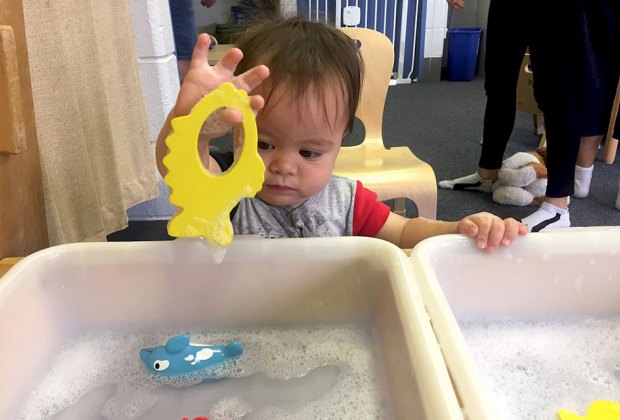
Let little ones splash and discover in a water sensory bin.
1. Water Sensory Bin
We started out by filling a giant clear plastic bin with water from the hose. Then we dropped in different toys in it to see if they would float or sink. Classic science experiment! My 2-year-old son was so enamored with the splashing that I eventually gave him a bucket so he could take the water out of the bin and splash it onto the patio, creating puddles, which were also ideal for splashing. The bin was eventually empty enough that both kids got in it themselves. Water can also lend itself to creating a toy or doll washing station with just a few drops of soap.

Make your own snow and let the kids create a winter scene.
2. Snow Sensory Bin
This is another free material that makes a great sensory bin item because it adds another sense outside of the five you usually think of: temperature. Those who don’t live in cold weather climates can buy a can of make-your-own snow but beware of its ingredients if you still have kids that put things in their mouths. We shoveled a scoop of the fresh stuff into a clear container and gave each kid a spray bottle filled with water and a few drops of food coloring (avoiding yellow, because my grandma always told me to beware of where the huskies go). Little People Elsa and Anna enjoyed being in their natural habitat, complete with a snow palace made using measuring cups.
3. Ice Sensory Bin
This one takes a little more planning ahead. Find some small toys (we used dinosaurs) and a container in your desired shape: muffin tins, Easter eggs (without holes), or water balloons if you’re doing just one toy, or a cardboard ice cream or milk carton if you want to use multiple toys. Place the toys in the containers and cover them with water. After about two hours, you’ll have a chilly sensory bin or item. You can talk to kids about what might make the ice melt faster (pouring water on it, playing in the sun, putting it on a dark-colored surface), or just enjoy the cold slippery feeling.

Make a spooky Halloween sensory bin with black beans that kids can scoop and measure. Photo by Sandy Fredricks
mediumrectangle-inline
mediumrectangle-inline
4. Dry beans or pasta
Dried items are different from wet in that they can create a satisfying sound and they’re generally easier to clean up. Beans come in a variety of colors, so you can use black beans for a space or Halloween theme, red beans for fall, and white beans for winter or Valentine’s Day. Pasta can be dyed to match various themes as well. Parents can mix in dollar-store toys like plastic spiders, heart or star beads, or fake leaves to match various themes.

Bring the beach home with a sand bin where kids can dig and discover buried treasures.
5. Sand or Cornmeal Sensory Bin
Beach or dinosaur-loving kids can enjoy getting dirty and digging with sand, and cornmeal is a great alternative to sand for those kids who still want to taste everything. Hiding seashells or dinosaurs in the table leads to a great sense of discovery for kids as they dig through the grit.
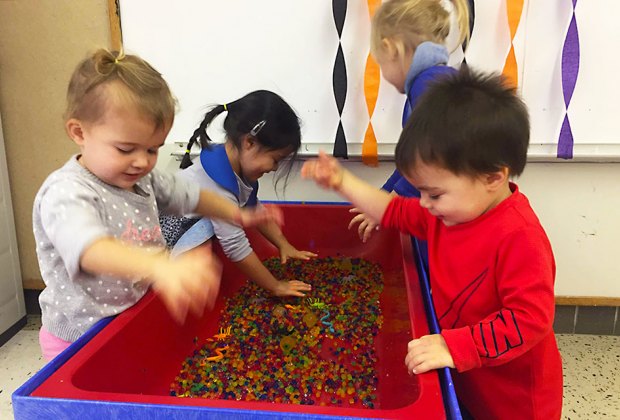
Slippery slimy water beads are a fun and newish addition to the sensory bin world.
6. Fun with Water Beads
These slimy, colorful balls slide in between little fingers and can be fun to spoon into different containers. Add water to make them grow, then let them dry out to return to regular size. This can create a fun beginning science lesson along with a satisfying finger feel. Grown-ups should beware of kids putting them in their mouths as they do expand.
7. Caps and/or Rice Sensory Bin Ideas
The tops from squeeze pouches of yogurt or applesauce always seem like a waste to throw away. They are often used to play paper football in our house, but a collection of them combined with rice can make a fun sensory bin. Kids can use the caps to scoop rice, or they can sort them by color. Grown-ups can even make rainbow rice by combining white rice, vinegar and food coloring Like pasta and beans, the rice makes an interesting sound. Just be sure to monitor their use, and any of the sensory bin items, with very young toddlers.
RELATED: 12 Sensory Playtime Ideas for Babies
mediumrectangle-inline
mediumrectangle-inline
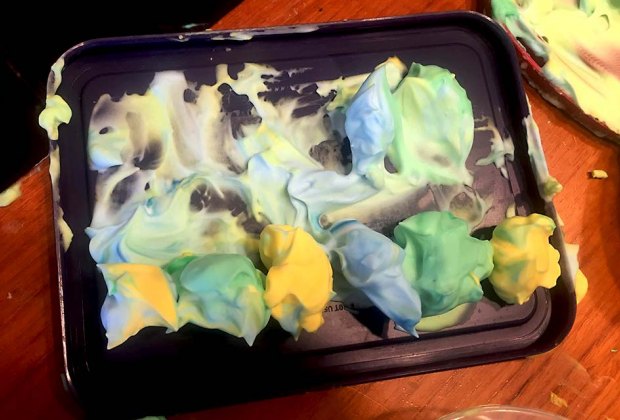
Draw pictures, practice letters and numbers, or just smash up shaving cream in a sensory bin.
8. Shaving Cream Sensory Bin
Like a lighter version of Play-doh, shaving cream is a substance that kids can mold to sculpt their own creations. We have hidden various small objects in the shaving cream to see if they can tell what is hidden without seeing it, or even dyed the cream into various colors to see what happens when you mix them together. Shaving creams come in many different scents these days, so pick one that is light and doesn’t overwhelm tiny noses. Not every kid loves the sticky feeling on their hands, so have plenty of towels at the ready for squeamish little ones.
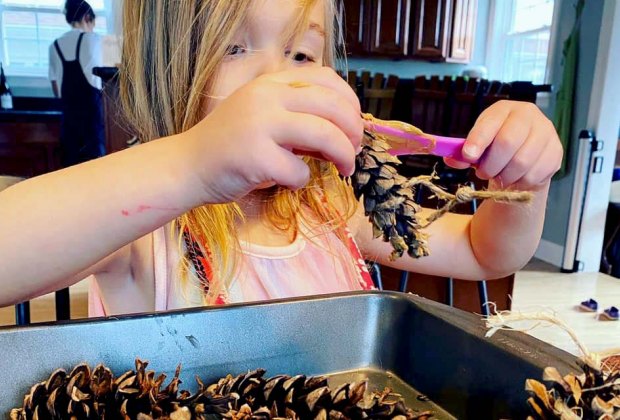
Take a walk to collect items to make your own nature sensory bin. Photo by Elizabeth Wollensak
9. Nature Sensory Bin
Scavenge your own backyard to find a variety of textures, colors, and scents to add to your nature bin. This is a great fall activity when many different plants are dropping leaves and seed pods. Look for pine cones, acorns, flower petals, sticks, and leaves. In the winter, fill the bin with artificial flower petals to create a fun Valentine’s Day-themed box to hide treats or tiny toys.
10. The Fluffy Sensory Bin
This is a good one for kids who don’t like getting wet or sticky. Choose pom-poms or even just plain ol'cotton balls to fill up your bin. Pom-poms allow kids to sort different colors and can fit into a seasonal theme, while cotton balls are a little cheaper and can be a fun stand-in for snow. Plus, cotton balls can be fun to pull apart and reshape.
Unless noted, photos by the author
mediumrectangle-inline
mediumrectangle-inline
